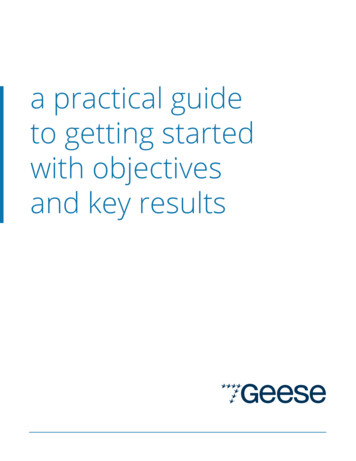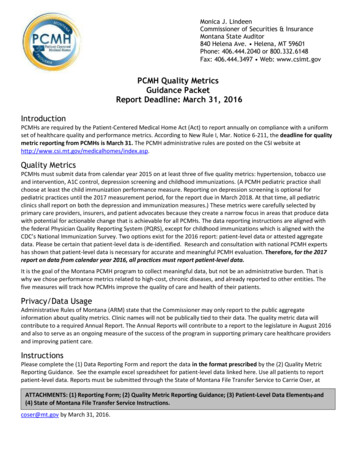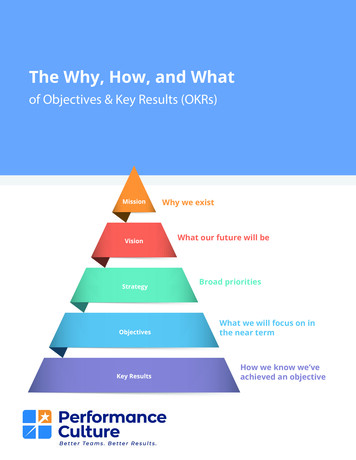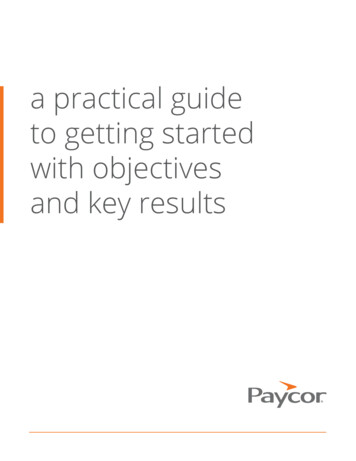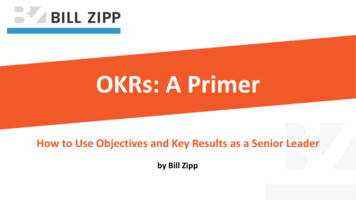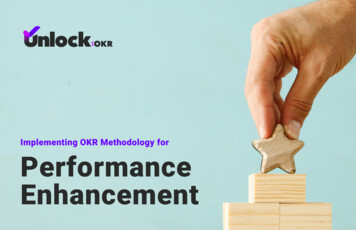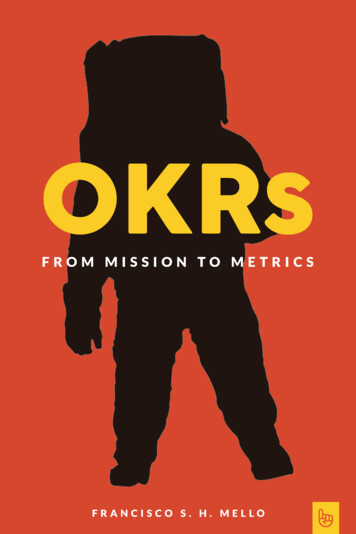
Transcription
OKRs, From Mission to MetricsHow Objectives and Key Results Can HelpYour Company Achieve Great ThingsFrancisco Souza Homem de MelloISBN 978-0-9904575-7-2 2016 - 2019 Qulture, Inc
To all my partners in crime at Qulture.Rocks.Q-Players, you guys Rock!
CONTENTSContentsPreface . . . . . . . . . . . . . . . . . . . . . . . . . . .i1. Introduction . . . . . . . . . . . . . . . . . . . . . .1What are OKRs? . . . . . . . . . . . . . . . . . . . .2Why use OKRs in managing your company? . . . .5Why are OKRs different? . . . . . . . . . . . . . . .92. A brief history of OKRs . . . . . . . . . . . . . . . . 10Mace and goal setting . . . . . . . . . . . . . . . . .12Peter Drucker, George Odiorne and MBO . . . . . .15Hoshin Kanri, or Policy Deployment, in Japan . . .18Andy Grove and Intel: iMBOs . . . . . . . . . . . . . 20John Doerr, Google and OKRs . . . . . . . . . . . . . 223. A bit of goal-setting scienceGoal-setting theory, or GST. . . . . . . . . . . . 24. . . . . . . . . . . . .25Getting goals right . . . . . . . . . . . . . . . . . . . 274. The current state of goal management . . . . . . 305. What’s different in OKRs . . . . . . . . . . . . . .OKRs, From Mission to Metrics Qulture.Rocks35
CONTENTSCompensation . . . . . . . . . . . . . . . . . . . . . 36Short cycles and nested cadences . . . . . . . . . . 39Transparency . . . . . . . . . . . . . . . . . . . . . . 40Bottom-up and top-down . . . . . . . . . . . . . .41Moonshots . . . . . . . . . . . . . . . . . . . . . . . 426. OKRs and strategy . . . . . . . . . . . . . . . . . . . 43Vision and mission. . . . . . . . . . . . . . . . . . 45Strategic OKRs . . . . . . . . . . . . . . . . . . . . .53Annual OKRs . . . . . . . . . . . . . . . . . . . . . . 577. The OKR short cycle . . . . . . . . . . . . . . . . . . 59Nested cadences, or cycles . . . . . . . . . . . . . . 60The short cycle . . . . . . . . . . . . . . . . . . . . . 628. Planning . . . . . . . . . . . . . . . . . . . . . . . . 64To cascade or not to cascade? That is the question . 66Unfolding and aligning OKRs . . . . . . . . . . . . .739. Monitoring . . . . . . . . . . . . . . . . . . . . . . . 85Results meetings . . . . . . . . . . . . . . . . . . . . 8610.Debriefing . . . . . . . . . . . . . . . . . . . . . . . 92Grading OKRs . . . . . . . . . . . . . . . . . . . . . . 93Running the debriefing . . . . . . . . . . . . . . . . 9611. Most common mistakes . . . . . . . . . . . . . . . 9712.Bibliography . . . . . . . . . . . . . . . . . . . . . . 104OKRs, From Mission to Metrics Qulture.Rocks
CONTENTSAcknowledgements. . . . . . . . . . . . . . . . . . . 107Final note . . . . . . . . . . . . . . . . . . . . . . . . . 108OKRs, From Mission to Metrics Qulture.Rocks
PrefaceThis is a great time to write about OKRs. I say that becausewe’re at a point of maximum opportunity: there’s neverbeen more interest in OKRs, on the one hand, and there’svery little understanding of the methodology, on the otherhand.I wrote this book to fill that opportunity gap.There’s no shortage of content around the internet and thebookshelves about the wonders OKRs can do for a company. John Doerr, famed venture capitalist and investorin the likes of Google, has done a terrific job, with hisMeasure What Matters, at selling us how amazing companiescan become if they incorporate OKRs in their managementroutines.However, managers and entrepreneurs who read these booksand, taken by a rush of excitement, decide to implementOKRs in their companies, get very frustrated soon thereafter. That’s because reading this stuff makes one conclude OKRs seem simple to implement. That couldn’t befurther from the truth. OKRs are tricky to implement once
iiPrefaceyou peel its first layer off. And this book aims at solvingthat.Our journeyI know how frustrating this journey can be firsthand. WhenI founded Qulture.Rocks, I had a hunch, which would laterbe confirmed, that goals must be an integral part of a company’s people management toolkit. So we built our product, which goes by the same name, to include goals alongside performance reviews, ongoing feedback and recognition, and one-on-one meetings.My conviction of the importance of goals logically led toimplementing them at Qulture.Rocks - one of our coreworking principles is to eat our own cooking, sometimescalled “dogfooding.” Therefore, from the very early dayswe’ve intended to use goals to manage the company.Around the same time, I leraned about OKRs and howthey were the answer to all the problems with traditionalgoal setting, perceived as too complex, bureaucratic, andinnefective. So I decided to focus on the OKR “flavour” ofgoals.Soon thereafter I became very frustrated: on the one side,questions were mounting on how to unfold OKRs, how toOKRs, From Mission to Metrics Qulture.Rocks
iiiPrefacemonitor them, how to link them to each other, etc. On theother side, there was very little content online - or offline,for that matter - with which we could answer them. Thatwas in early 2016.A wave of new content about the subject would infuseus with hope. During the remainder of 2016, then 2017and 2018, many books and blog posts were written aboutOKRs. With each announcement, our hopes went up. Witheach release, they came crashing down. These books andarticles were great, but their substance either didn’t applyto our reality (because they were written for very smallpre-product/market fit startups or agile product teams) orthey just lacked sufficient details on the tactics of implementing OKRs throughout an entire organization.Then came John Doerr’s Measure What Matters, which Iexpected would be the definitive guide to OKRs. The bookdrove an explosion of interest in the subject. I had manyfellow entrepreneurs come to me during our Y Combinatorbatch, book in hand, to tell how great OKRs had to be, since,in Doerr’s words, they were the secret behind Google’sgrowth. They also came with many many questions, knowing I was the OKR “expert.” The book had made an amazingjob at drawing their interest, but left many gaps wide openthat would jeopardize an attempt to implement OKRs.That’s about when I decided to write this book. I realized weOKRs, From Mission to Metrics Qulture.Rocks
ivPrefacehad to fill that gap and help empower organizations aroundthe world to implement OKRs for real.In order to write the book, I had to read, basically, everything ever written about OKRs, and then look for the origins of the methodology, that were rooted in Managementby Objectives, Hoshin Kanri, and goal-setting theory, orGST.I read authors like Cristina Wodtke, Ben Lamorte, PaulNiven, John Doerr, Dan Montgomery, Laszlo Bock, and soon and so forth. The list is big. And the feeling of emptyness persisted. There was a lot of cheering OKRs, and verylittle explaining how a company can run by them on the dayto day. But then, I also read the stuff these authors werereferrenicing on their books, like books written by PeterDrucker and Andy Grove. And what I found out was thatthese sources were still pretty perfunctory - they barelyscratched the surface. It wasn’t enough.So I dug deeper, and then, finally, struck gold. I found amissing link in authors such as Michelle Bechtell, GeorgeOdiorne, Yoki Akao, Vicente Falconi, Thomas Jackson, RandyKesterson, and Pete Babich. And by looking at these oftenuncited authors and their works, I found answers to manyof the questions that were lingering in my head.Closing those gaps made all the difference. The symptomOKRs, From Mission to Metrics Qulture.Rocks
vPrefacewas clear: Using OKRs at Qulture.Rocks became much morefun and effective, and I started to finally feel we were doinga good job at figuring out our strategy and then executingit with excellence.Why another book about OKRs?After seeing firsthand how amazing OKRs could be at ourown company, I decided to take that knowledge to othercompanies, and what better way to do that than write abook about the subject?I had one major goal in writing the book: helping companies implement OKRs. I also knew that our book wouldprobably not be the first contact our readers would havewith OKRs. They’d probably get to John Doerr or someother author much faster. So I decided to tackle some ofwhat I understood where conflicting definitions and contradictions found in those authors’ works.These contradictions basically arose from either the poorquality of examples used by authors and sources, such asGoogle’s re:Work website, or by lack of depth in explaininghow to actually do it in a company, with various teams, layers of management, etc. Deeper, more relevant examples.I trully hope you enjoy this book and that it helps yourOKRs, From Mission to Metrics Qulture.Rocks
viPrefaceorganization achieve great things.- Francisco S. Homem de MelloFounder and CEO, Qulture.RocksSan Francisco, January 18th, 2019OKRs, From Mission to Metrics Qulture.Rocks
1. Introduction“OKRs have helped us on the road to growth many, manytimes”-Larry Page“If you do not know where you’re going, you probably willnot get there”-Yogi Berra“Vision without execution is just hallucination”-Thomas EdisonOKRs are a powerful management tool that has been gaining ground among innovative companies in the technology, retail and even non-profit sectors. Some of the world’sbest-known organizations that use it are Google, Dropbox,Twitter, the Gates Foundation, and also more traditionalcompanies like AB Inbev and Disney.This book works as a practical guide to understand whatOKRs are and how to apply them in your company.
2IntroductionWhat are OKRs?“OKRs” stands for Objectives and Key Results.OKRs are a tool for guiding and executing the strategy ofthe organization. They happen through the deployment ofbusiness Objectives throughout individuals and teams.In some respects, they follow the same logic as traditionalgoals, based on the Balanced Scorecard, Hoshin Kanri, orManagement by Objectives, but they have their own agile flavor which makes them more useful to the businesschallenges of modern companies and professionals.An OKR is a set of one Objective and n Key Results.The Objective is the business result that needs to be achieved,and should be written in qualitative terms.The Key Results are S.M.A.R.T. (an acronym for specific,measurable, attainable, relevant and time-bound) goalsbased on specific key performance indicators.Key Results must help “prove” if the Objective was achieved.A good OKR should be built in such a way that if the KeyResults are all achieved, you should feel comfortable thatthe Objective has been reached. They must serve as proofOKRs, From Mission to Metrics Qulture.Rocks
3Introductionof the attainment of the Objective. Alternatively, if youfeel that your Objective hasn’t quite been achieved eventhough all Key Results were achieved, there was a problemwith your Key Results to start with.You can use a very simple statement to help form an OKR:“We will , and we will know if we were successfulif we can , , .”The first space is filled by your Objective, and the secondto the fourth are filled by the Key Results.Let’s use an example to illustrate our definition: Objective: Increase the profitability of the company Key Results: i) Grow the company’s net income to 100 million, and ii) Reach a net profit margin of morethan 7%.Since OKRs belong to cycles, if they don’t have an explicitend date, you must automatically assume that they mustbe completed before the end of the cycle. Cycles of OKRsgenerally last 3 months, a period within which the OKRsare established, monitored, and evaluated, and from whicha new cycle begins, ad eternum.OKRs, From Mission to Metrics Qulture.Rocks
4IntroductionBack to our example. If we fill in the gaps above, we willhave:“We will increase the profitability of the company, and wewill know if we were successful if we can grow thecompany’s net income to 100 million and reach a net profitmargin of more than 7%.OKRs, From Mission to Metrics Qulture.Rocks
5IntroductionWhy use OKRs in managing yourcompany?OKRs are a management tool that brings many great benefits to any company that uses them the right way. Let’s seewhat some of these benefits are:Focus and prioritizationOKRs force organizations (and teams and individuals) toprioritize the most important business results in a givenperiod (for example, next quarter), and ripple that focusand prioritization throughout the organization.The focusing effect of OKRs is well documented and researched, especially through the work of American academic Edwin Locke.AlignmentOKRs come from the company’s mission and vision in aprocess of alignment that has the ultimate goal of gettingeveryone to know in which direction they should row, hereand now.OKRs, From Mission to Metrics Qulture.Rocks
6IntroductionThis alignment process happens in two dimensions: throughtime and through the organization.The company creates its strategic OKRs aligned to the mission and the vision. It then creates its annual OKRs alignedto its strategic OKRs. That’s aligning them through time.Within the same cycle different people and teams withinthe organization also align their OKRs to each other. VPscreate their OKRs in alignment with the company’s. Directors create their OKRs in alignment with VPs’. Squadscreate their OKRs in alignment with the OKRs of businessunits, and with each other’s. That’s aligning them throughthe organization.The alignment superpower is enhanced by the fact thatOKRs are public by default. Dependencies and conflictingOKRs can be promptly identified, discussed, and resolved.MotivationIt’s scientifically proven (again by Locke, long before theterm “OKR” existed), that difficult but achievable goalsincrease task-related motivation.Because OKRs are less directly linked to employee compensation (i.e., they’re a management tool rather than aOKRs, From Mission to Metrics Qulture.Rocks
7Introductioncompensation management tool, which we’ll talk moreabout this later), supporting aggressive goals is encouraged. These goals are called roof-shots, or even moonshots, depending on how bold they are.Vicente Falconi, a Brazilian management guru, relates difficult goals to employee engagement when he says that“from the point of view of the people involved, the value ofthe goal must be above their capacity to reach it, in a waythat they need to learn and grow in the process of workingtowards it.”CultureOKRs are a very powerful tool for solidifying a culture ofexecution and results orientation.Perhaps 9 out of 10 companies have, among their corporate competencies, values, or strategic guidelines, somevariation of “results orientation.” But what does “resultsorientation” mean?In our view, a results-oriented professional clearly knowsthe difference between an effort and a result. Let’s look atsome efforts and results that are often confused: Attending a sales meeting (or 50, for that matter) isOKRs, From Mission to Metrics Qulture.Rocks
8Introductionan effort. Closing sales is a result. Implementing an ERP system is an effort. Reducingaccounting errors is a result. Building a new feature for the e-commerce shoppingcart is an effort. Increasing the conversion rate is aresult.The relationship between efforts and results is always relative. To illustrate this, let’s think about football. “Running faster” is a result of the “workout” effort, but “running faster” is also an effort to “score more goals.” And“scoring more goals” is an effort to “win the game.”An OKRs should track results relative to the person orteam that owns them. So, if a product team works exclusively with the shopping cart feature, its Objective will besomething like “improve shopping cart conversion rates,”and the Key Result will be “improve the conversion ratebetween adding items to the shopping cart and making apurchase from 3% to 5%.”As people better understand what the results of their efforts are, they create a culture of fewer politics, less subjectivity, and more, voilá, results orientation!OKRs, From Mission to Metrics Qulture.Rocks
9IntroductionWhy are OKRs different?OKRs, in their current application in the Silicon Valley, aredifferent than regular goals in the following ways: They aren’t defined solely top-down: OKRs should beset from both the bottom-up and from the top-down.In practice, employees take a more active role in theprocess. They’re less directly linked to variable compensationplans, like pay-for-performance bonuses (we’ll talkmore about this soon). They’re run in shorter cycles of 3, 4 or 6 months. They’re public by default. That means that confidential OKRs are the exception, and not the rule (goalsrelated to mergers and acquisitions or downsizingplans are some examples of private OKRs).OKRs, From Mission to Metrics Qulture.Rocks
2. A brief history of OKRsOKRs are goals: old pals from the business world, renamedand tailored to the needs of modern professionals andcompanies.It all started with the fathers of management, Taylor andFayol, who began to face management as a science. Theypioneered measuring the times and motions of productionline jobs, correlating that to productivity (basically output per unit of input), and then formulating hypothesesabout how to improve these results. That’s how these guysfound out interesting things like the ideal resting timefor workers of a given factory, where equipment shouldbe placed around the worker for optimum reach and evenbetter lighting schemes over the production line that minimized the amount of mistakes and waste. In 1916 Fayolwas already proposing the use of goals in the managementplanning process, according to William LaFollette, in hisThe Historial Antecedents of Management by Objectives,saying that “ in 1916 Henri Fayol identified five functionsofmanagement: planning, organizing, conmand, coordination, and control. Fayol considered the planning func-
A brief history of OKRs11tion to consist of visualizing the desired end (i.e., theobjective or goal), the line of action to be followed, thestages to be followed in sequence, and the methods thatwould be used. Unfortunately Fayol’s work was unknownin America for some years.”OKRs, From Mission to Metrics Qulture.Rocks
A brief history of OKRs12Mace and goal settingAround 1935, a guy named Cecil Alec Mace conducted thefirst experiments that would prove that goals improve theperformance of workers performing a job.Mace was born on July 22, 1894 in Norwich, Great Britain.Mace’s early passion was theology, and he actually wentto Cambridge to enter the holy orders, but ended takingup the Moral Sciences. While at Cambridge, Mace tookmany psychology courses (with mentors and tutors likeG.E. Moore, C.S. Meyers, and G.F. Stout), and delved intoexperimental psychology, a field that would define hiscareer.In 1935, Mace conducted the first experimental study ofgoal-setting and in the following years discovered manyof the basic principles that are taught today. His findings are absolutely aligned with further discoveries, fromGarry Latham and Edwin Locke: first, performance is dependent on the existence of goals. Second, goals can beassigned to individuals, and unless they are too hard toachieve (unreallistic), will be accepted by said indivuals.Third, goals can be assigned for a variety of outcomes:for any performance criterium that can be measured, agoal can be set. Fourth, a tough, specific goal will lead toOKRs, From Mission to Metrics Qulture.Rocks
A brief history of OKRs13greater increments in performance than a nonspecific, “doyour best” instruction. Fifth, goals increase performanceless through intensifying effort than through prolongingeffort. And last, despite a worker’s internal motivation,without external goal assignment, workers will performbellow their abilities.Mace also found out that in order for goals to be effective,individuals need to have constant feedback about theirperformance in comparison to the goal at hand, and eventual discrepancies.Since a lot is spoken these days about what motivatesindividuals at work (the subject of extremely popular bookssuch as Drive, by Daniel Pink, and Payoff, by Dan Ariely), itis very interesting to note that Mace was already reachingvery similar conclusions around that time. According toMace,“Traditional doctrine has been oversimple. The mistake of the worldly wise, who like to say that “the onlyeffective incentive is the pay-packet”, is not so muchthat they overlook other sources of motivation as thatthey fail to observe the complexity of this motive itself.We all love money, but we love it most for what itenables us to do. To some it may mean chiefly beer andcircuses, to others it means greater security, or a betterOKRs, From Mission to Metrics Qulture.Rocks
A brief history of OKRs14chance for one’s children, or greater opportunity forpromoting a project for reforming the world. The paypacket theory is not a bad one to start from, but it is aptto stifle thought precisely at the point where thoughtshould begin.”After Mace’s came many studies about the effectivenessof goal-setting in task performance. The subject would belater developed definitively by Locke and Latham, who’dgo on to write the bible on the subject.OKRs, From Mission to Metrics Qulture.Rocks
A brief history of OKRs15Peter Drucker, George Odiorne and MBOIn the 1950s, Peter Drucker, who is believed to be thegreatest management guru of all time, articulated, in oneof his books, that goals could be a great way to measure theperformance of managers, a new breed of workers that waspopping up left and right on the US economy.Drucker concluded that managers should set goals aroundproductivity improvements and other measurable outcomes,check performance against those goals from time to timeand get on a process of continuous improvement.He called it “management by objectives and Self-Control”,or “MBO”, a concept introduced in The Practice of Management (Nobody knows who first used the term “MBOs”, butit’s widely said that it was Drucker. Drucker, on the otherhand, actually claims he first heard the term from GeneralMotors’s Alfred Sloan).At the time, one of the most prominent companies toadopt the methodology was HP. Other practitioners included General Mills, DuPont, and General Electric.Drucker viewed MBO as a management philosophy. According to him, in The Practice of Management, “ What thebusiness enterprise needs is a principle of managementOKRs, From Mission to Metrics Qulture.Rocks
A brief history of OKRs16that will give full scope to individual strength and responsibility, and at the same time give common direction ofvision and effort, establish team work and harmonize thegoals of the individual with the common weal. The onlyprinciple that can do this is management by objectives andself-control.”Contrary to what’s currently widely believed, MBO wasn’tmeant to be top-down nor about controlling people ina mechanistic way. Again according to Drucker, and theemphasis here is mine, “[MBO] requires each managerto develop and set the objectives of his unit himself.Higher management must, of course, reserve the power toapprove or disapprove these objectives. But their development is part of a manager’s responsibility; indeed, it ishis first responsibility. It means, too, that every managershould responsibly participate in the development of theobjectives of the higher unit of which his is a part. To“give him a sense of participation” (to use a pet phraseof the “human relations” jargon) is not enough,” and“The greatest advantage of management by objectives isperhaps that it makes it possible for a manager to controlhis own performance. Self-control means stronger motivation: a desire to do the best rather than just enough toget by. It means higher performance goals and broader vision. Even if management by objectives were not necessaryto give the enterprise the unity of direction and effort of aOKRs, From Mission to Metrics Qulture.Rocks
A brief history of OKRs17management team, it would be necessary to make possiblemanagement by self-control.Drucker’s work didn’t delve into the specifics of how toapply MBO to an organization. That work was done, in part,by his student pupils, like George Odiorne, who went on towrite books about the subject and consult with many largecompanies in the USA.OKRs, From Mission to Metrics Qulture.Rocks
A brief history of OKRs18Hoshin Kanri, or Policy Deployment, inJapanAround the 50s, in post-war Japan, W. Edwards Demmingand the Japanese manufacturers were developing ways toincrease the quality of Japanese products by enhancingtheir manufacturing processes. Demming had been sent toJapan by the US Government to help rebuild the country’seconomy, which had been devastated by World War II.That’s where methodologies like Six Sigma, TQC - TotalQuality Control, and the “Toyota Way” were born.In Japan, something similar to MBO was developed. It wascalled Hoshin Kanri, or “policy deployment,” a methodology that was part of larger Total Quality Management,and through its process the goals, or hoshins, were unfolded annually throughout the organization. By the way,we believe that the Hoshin Kanri literature is critical forany company that wants to become an excellent OKR practitioner.Since the introduction of MBOs and the TQC, practicallyevery modern company is managed using some form ofgoals. Some companies set annual goals; others do it twicea year. Some tie pay-for-performance bonuses to the achievement of goals; others run some sort of performance reviewOKRs, From Mission to Metrics Qulture.Rocks
A brief history of OKRs19based on goals attainment. But most of the Fortune 500 usegoals and have them as a key part of their compensationmanagement stack.OKRs, From Mission to Metrics Qulture.Rocks
A brief history of OKRs20Andy Grove and Intel: iMBOsThe term “OKRs” was coined, as far as is known, by AndyGrove, the western name of András István Gróf, an hungarian immigrant. Grove was the CEO of Intel for morethan 10 years, wrote best-selling business books like HighOutput Management and Only The Paranoid Survive, and laterteached strategy for high-technology companies at Stanford.At Intel, goal-management was called “iMBO,” or “IntelManagement by Objectives” (referring to the term MBO,from Drucker.) Everybody in the office staff took part init, establishing annual and quarterly Objectives (whichresembled SMART goals) and time-bound milestones toachieve those Objectives, which Grove dubbed Key Results.The methodology was taught in an onboarding course thoughwhich all those employees went called Intel’s Organization,Philosophy, and Economics.Grove didn’t bring any transformational insight into theMBO framework, but instead suggested that its employeesdescribe their goals (which were basically SMART goals) inconjunction with what they called Key Results, which weresteps or action plans that guided the collaborator towardsthe goal.OKRs, From Mission to Metrics Qulture.Rocks
A brief history of OKRs21In Grove’s view, key results were primarily milestones thatwould lead someone to achieve their objectives: a goalto “Dominate the mid-range microcomputer componentbusiness” would be followed by a key result to “win newdesigns for the 8085.” Even though Grove stressed thatkey results should be measurable, his examples all closelyresemble efforts, or deliverables, as part of an action plan,and don’t look like actual results.Grove’s other contribution to OKRs was his belief thatObjectives and Key Results should be defined in a twoway process: from top to bottom, in the case of StrategicObjectives that should be deployed to different executivesand business units, but also from the bottom up, fromthe individual contributor herself, so as to bring commitment and empowerment to the process. It was far froma novel concept, but one that had been partially lost inbig American companies, which pushed goals “down theline” throughout the organization, from the Board to theCEO, from the CEO to the VPs, and so on. Grove encouraged Intel employees to define their goals according to thegoals of the company, and then calibrate them with theirmanagers.Last but not least, Grove insisted that OKRs were aggressive, meaning difficult to achieve, and what he called “stretchgoals.”OKRs, From Mission to Metrics Qulture.Rocks
A brief history of OKRs22John Doerr, Google and OKRsIn the late 1990s, OKRs spread to other Silicon Valley companies through the hands of Jon Doerr, a partner at KleinerPerkins (now KPCB), one of the world’s most respectedventure capital firms. Doerr had worked at Intel indirectlyunder Grove, and used iMBOs. He later spread the methodology to some of his portfolio companies at Kleiner Perkins,the most important of which was a startup founded by twoStanford PhD students who had created an excellent websearch engine. The startup was Google.At Google, OKRs took many different forms and gainedworldwide fame. Larry Page, cofounder of Google, claimsthat “OKRs helped lead [Google] to 10x growth, manytimes over. They’ve helped make [Google’s] crazily boldmission of ‘organizing the world’s information’ perhapseven achievable [OKRs] kept me and the rest of thecompany on time and on track when it mattered the most.”Google operates under a very loosely standardized flavourof OKRs. Aside from salespeople, who have goals that areset in a more top-down fashion and according to budget,most other teams, like product and engineering, are freeto use OKRs or not, and use OKRs with varying degreesof homogeneity and effectiveness. In common betweenOKRs, From Mission to Metrics Qulture.Rocks
A brief history of OKRs23all of these flavours, OKRs are treated as more of an HRperformance management tool than a management philosophy. They are graded at the end of every performancemanagement cycle in a five-point rating scale (0.0, 0.3,0.5, 0.7, and 1.0).
term “OKR” existed), that difficult but achievable goals increasetask-relatedmotivation. Because OKRs are less directly linked to employee com-pensation (i.e., they’re a management tool rather than
